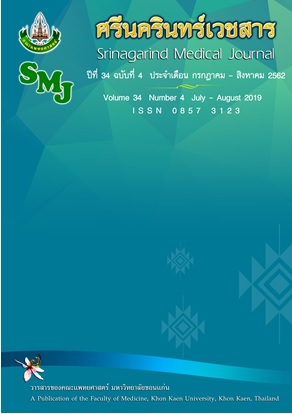Meditation Training for Reducing Complications and Improving Cardiac Function in Post Coronary Artery Bypass graft Patients
Keywords:
การผ่าตัดเบี่ยงเบนหลอดเลือดหัวใจ(CABG); วิปัสสนาสมาธิ; การทดสอบการเดิน 6 นาที(6MWT); ค่าอัตราการตกตะกอนของเม็ดเลือดแดงใน 1 ชั่วโมง (ESR)Abstract
Background and Objective : To study the effects of mindful meditation on post coronary artery bypass graft (CABG) patients to 1. cardiac arrhythmia event, length of hospital stay 2. 6MWT 3. Erythrocyte sedimentation rate (ESR)
Methodology : This study is quasi-experimental research .Patients were divided into 2 groups. 1) Control group with 21 patients no mindful meditation training 2. Experimental group with 21 patients that provides mindful meditation training . Duration of study period were 1 year 6 months. 3 sets of data collecting records were used; 1. vital signs and EKG in the first 3 days after surgery, 2. 6MWT after discharged for 2 and 6 weeks and 3. Check the ESR value on day 1-5 after surgery.
Results : The research found that 1) The incidence of cardiac arrhythmias and duration of hospital stay after CABG were not significantly different in control and experiment groups (p=1.00 and p=0.6809, respectively). 2) The distance of 6MWT after discharge for 2 and 6 weeks between control and experiment group were not significantly different (p= 0.5030 and p=0.3839), but there was statistical significantly different of distance between 2 and 6 weeks after discharge in the experimental group (p= 0.0003) while of the control group showed no statistical difference. 3) ESR on day 1-5 after surgery between the two groups after surgery was not statisticantly different (p> 0.01)
Conclusion: Training mindful meditation before surgery, resulting in increase 6MWT distance in post CABG after 6 weeks discharge patients .Therefore, it should be encouraged to practice mindful meditation in those who are cardiac surgery.
References
2.Fiorina C, Vizzardi E, Lorusso R, Maggio M, De Cicco G, Nodari S, et al. The 6-min walking test early after cardiac surgery. Reference values and the effects of rehabilitation programme. Eur J Cardiothorac Surg 2007;32: 724-9.
3.Herbert F. Jelinek, Zhaoqi Q. Huang, Ahsan H. Khandoker, Dennis Chang, and Hosen Kiat. Cardiac rehabilitation outcomes following a 6-week program of PCI and CABG Patients. Front Physiol 2013; 4: 302.
4.งานเวชระเบียนและสถิติ. สถิติผู้ป่วยผ่าตัดหัวใจ ปี 2552-2556 [เอกสาร]. ขอนแก่น: มหาวิทยาลัยขอนแก่น; 2556.
5.Martin CG, and Turkelson SL. Nursing care of the patient undergoing coronary artery bypass grafting. Eur J Cardiovasc Nurs 2006 ; 21: 109-17.
6.ธิติสุดา สมเวที,ลินจง โปธิบาล และภารดี นานาศิลป์. ผลของการปฏิบัติสมาธิเคลื่อนไหวไทยซี่กงต่อ ความดันโลหิตในผู้สูงอายุโรคความดันโลหิตสูง.พยาบาลสาร 2554; 38: 81-92.
7.ประภาส จิบสมานบุญ,อุบล สุทธิเนียม. สมาธิบำบัด SKT 2 ต่อระดับความดันโลหิตและตัวบ่งชี้ทางเคมี. วารสารวิทยาลัยพยาบาลบรมราชชนนี กรุงเทพ 2556; 29: 122-32.
8.สมพร กันทรดุษฎี. การปฏิบัติสมาธิเพื่อการเยียวยาสุขภาพ กรุงเทพฯ.โรงพิมพ์ทหารผ่านศึก. 2549.
9.Lazer SW, Bush G, Gollub RI, Friechione GI, Khalsa G, Benson H. Functional brain mapping of the relaxation response and meditation [Autonomic Nervous System]. Neuroreport 2000; 11: 1581-5.
10.แพทย์พงษ์ วรพงศ์พิเชษฐ. Mind and Body Medicine ตอนที่ 2 สมาธิบำบัด.วารสารสำนักการแพทย์
ทางเลือก 2555; 4: 9-16.
11.Davidson RJ, Kabat-Zinn J, Schumacher J, Rosenkranz M, Muller D, Santorelli SF, et al. Alterations in brain and immune function produced by mindfulness meditation. Psychosom Med 2003; 65: 564-70.
12.Cohen J. Statistical power analysis for the behavioralsciences. 2nd ed. Lawrence Erlbaum Associates Publishers; 1988: 1-599.
13.แพรวพรรณ สุวรรณกิจ, ประกายดาว สุขเทศ, ศตวรรษ วงษา, อรอุมา อุดทา. ผลของการฝึกสหจะโยคะ
สมาธิต่อความดันโลหิต อัตราการเต้นของหัวใจ และความเครียดในผู้ป่วยความดันโลหิตสูง.วารสาร
การพยาบาลและสุขภาพ. 2553; 4: 28-35.
14.บุญใจ ศรีสถิตนรากูร.ระเบียบวิธีวิจัยทางพยาบาลศาสตร์. พิมพ์ครั้งที่ 3. กรุงเทพฯ. ยูแอนด์โอ อินเตอร์
มีเดีย. 2547.
15.Peretto G, Durante A, Limite L R, Cianflone D. Review Article: Postoperative Arrhythmias after Cardiac Surgery; Incidence, Risk Factors, and Therapeutic Management. Cardiol Res Pract 2014: 1-15.
16.American Thoracic Society. Guidelines for the Six-Minute Walk Test. American Journal Of Respiratory and Critical Care Medicine 2002: 111-7.
17.Bittner V, Weiner DH, Yusuf S, Rogers WJ, McIntyre KM, Bangdiwala SI, et al. Prediction of mortality and morbidity with a 6-minute walk test in patients with left ventricular dysfunction. SOLVD Investigators. JAMA 1993; 270: 1702-7.
18.ฉัตรชัย ศรีบัณฑิต.ภาวะการอักเสบในร่างกายเกิดขึ้นได้อย่างไร[อินเทอร์เน็ต].กรุงเทพฯ:แอ็บโซลูท เฮลธ์ คลินิก[เข้าถึงเมื่อ 18 ต.ค. 2556]. เข้าถึงได้จาก http://www.absolute-health.org/thai/article-th-040.htm
19.Togan T,Gunday M,Ciftci O. and Bingol H. Can preoperative erythrocyte sedimentation rate serve as an indicator for midterm adverse events after coronary bypass grafting? Heart Surg Forum 2015 ;18: E047-52. doi: 10.1532/hsf.1245.




